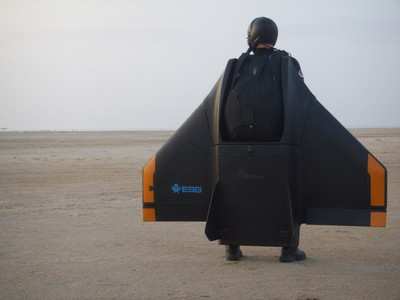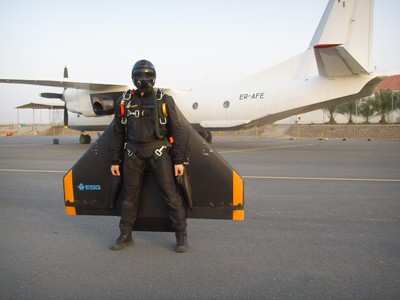Sun, May 04, 2008
Can Travel 125 Miles From 30,000 Feet... At 135 MPH
Don't confuse the next item with the opening of the film "Iron
Man" this weekend -- this is the real deal. It may not outrun a
Raptor... but its agility and stealth could revolutionize skydiving
as a sport, and eventually see its way to combat.

The Gryphon attack glider designed by SPELCO GbR weighs only 30
pounds and has a 6-foot swept-wing that is steered with handheld
rotary controls connected to its rudder. It can be fully weaponized
for assault and hide more than 100 pounds of combat gear in a
built-in compartment.
Designed to penetrate combat zones at 135 miles per hour, the
Gryphon is maneuverable enough to fly through the legs of Paris'
Eiffel Tower at high speed, as demonstrated through a simulation to
FOX News recently. The wing separates from the pack before the
parachute is deployed and remains connected via a cord, allowing it
to land before the pilot.
SPELCO hopes to offer the Gryphon to armed forces as a solution
to high altitude, high opening (HAHO) missions. Currently such
missions require jumps close to combat zones since traditional
parachutes only travel around 30 miles from the drop point to the
landing zone.
Future plans by SPELCO for the Gryphon include incorporation of
a small turbojet like those used for Unmanned Aerial Vehicle (UAV)
propulsion. Such an addition would eliminate the need to exit at a
high altitude to cover large distances... or, give soldiers added
time, and distance.
With its 5.1 glide ratio and on-board oxygen
system, a jet-powered Gryphon could allow soldiers to
exit up to 125 miles away from the landing zone at an altitude of
30,000 feet, far away from high-risk combat zones. The speed of the
Gryphon reduces the time of descent to from the typical 45 minutes
of a current HAHO mission to only 15 minutes -- significantly
reducing exposure to extreme cold at altitude, and possibility of
detection.

The compact design of the Gryphon with all equipment contained
within the lifting body gives the unit a very small radar
signature, making it an obvious choice for stealth missions.
More News
How To Get A Story On Aero-TV News/Feature Programming How do I submit a story idea or lead to Aero-TV? If you would like to submit a story idea or lead, please contact Jim Campbel>[...]
Aero Linx: International Association of Professional Gyroplane Training (IAPGT) We are an Association of people who fly, build or regulate Gyroplanes, who have a dream of a single >[...]
NORDO (No Radio) Aircraft that cannot or do not communicate by radio when radio communication is required are referred to as “NORDO.”>[...]
Beyond Visual Line Of Sight (BVLOS) The operation of a UAS beyond the visual capability of the flight crew members (i.e., remote pilot in command [RPIC], the person manipulating th>[...]
Aero Linx: Malibu M-Class Owners and Pilots Association (MMOPA) The Piper M-Class Owners & Pilots Association (PMOPA) is a not-for-profit organization dedicated to the interest>[...]
 ANN FAQ: Contributing To Aero-TV
ANN FAQ: Contributing To Aero-TV ANN's Daily Aero-Linx (05.29.24)
ANN's Daily Aero-Linx (05.29.24) ANN's Daily Aero-Term (05.29.24): NORDO (No Radio)
ANN's Daily Aero-Term (05.29.24): NORDO (No Radio) ANN's Daily Aero-Term (05.30.24): Beyond Visual Line Of Sight (BVLOS)
ANN's Daily Aero-Term (05.30.24): Beyond Visual Line Of Sight (BVLOS) ANN's Daily Aero-Linx (05.30.24)
ANN's Daily Aero-Linx (05.30.24)




